Tuesday Nov. 13, 2007
The revised Experiment #2 reports have been graded and can be picked up
in class.
Optional Assignment #6 was collected in class today.
The Experiment #4 reports are due on Thursday. If you
haven't already returned the materials, you should try to do so by
Wednesday. You can return the materials in PAS 588 and pick up
the
Supplementary Information sheet.
Thursday is also the first of the 1S1P Assignment #3 due dates.
If you plan to do two reports this time, at least one report must be
turned in on Thursday this week.
We
started class with a new topic - thermal circulations.
Differences
in temperature, such
as might develop between a coast and
the ocean or between a city and the surrounding country side, can
create
horizontal pressure differences. The horizontal pressure gradient can
then produce a wind flow pattern known as a thermal circulation.
These are generally relatively small scale circulations and the
pressure gradient is so much stronger than the Coriolis force that the
Coriolis force can be ignored. We will learn how thermal
circulations develop and then apply to concept to the earth as a
whole
in order to understand large global scale pressure and wind
patterns. You'll find the
following discussion on p. 131 in the photocopied Class Notes.
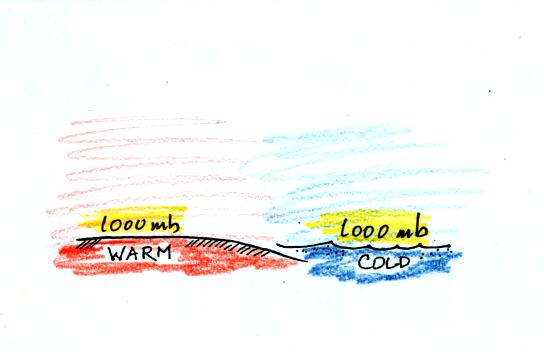
A beach will often become much warmer than the
nearby
ocean during
the day (the sand gets hot enough that it is painful to walk across in
barefeet). Pressure will decrease more slowly with increasing
altitude in the warm low density
air than in the cold higher density
air above the ocean.

Even when the sea level pressures are the
same over the land and water (1000 mb above) an upper level pressure
gradient can be created. The upper level pressure
gradient force will
cause upper level winds to
blow from H (910 mb) toward L (890 mb).

The movement of air above the ground can affect the
surface
pressures. As air above the ground begins to move from left to
right, the surface pressure at left will decrease (from 1000 mb to 990
mb
in the picture below). Adding air at right will increase the
surface pressure there (from 1000 to 1010 mb).
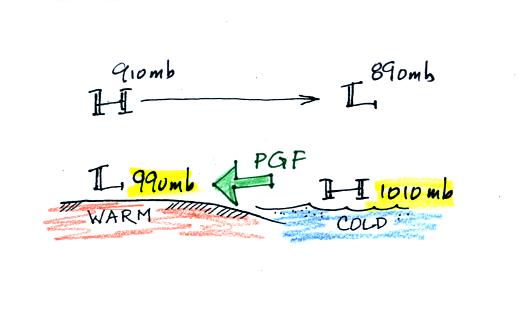
This creates a
surface
pressure gradient.

The surface winds blow from high to low.
The surface
winds and
upper level winds are blowing in opposite directions.
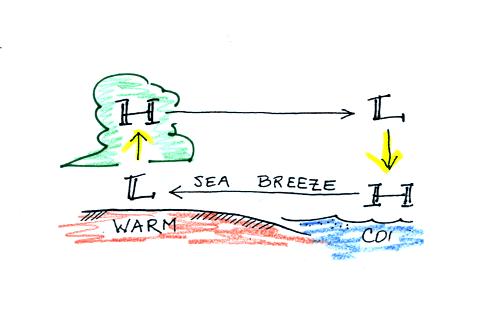
You can complete the circulation loop by adding rising air above the
surface low pressure at left and sinking air above the surface high at
right. The surface winds which blow from the ocean onto land are
called a sea breeze (the name tells you where the winds come
from). Since this air is likely to be moist, cloud formation is
likely when the air rises over the warm ground.
At night the ground cools more quickly than the ocean and becomes
colder than the water. The thermal circulation pattern reverses
direction. Surface winds blow from the land out over the
ocean. This is referred to as a land breeze.
Here's
another example of a thermal circulation

Cities are often warmer than the surrounding
countryside,
especially at night. This is referred to as the urban heat island
effect. This difference in temperature can create a
"country breeze."
The Asian
monsoon (monsoon refers to a seasonal change
in the direction of the prevailing winds) is a large scale circulation
pattern and is much more complex than a simple thermal
circulation. However you can
use the thermal circulation concept to get a general understanding of
what to expect at different times of the year.
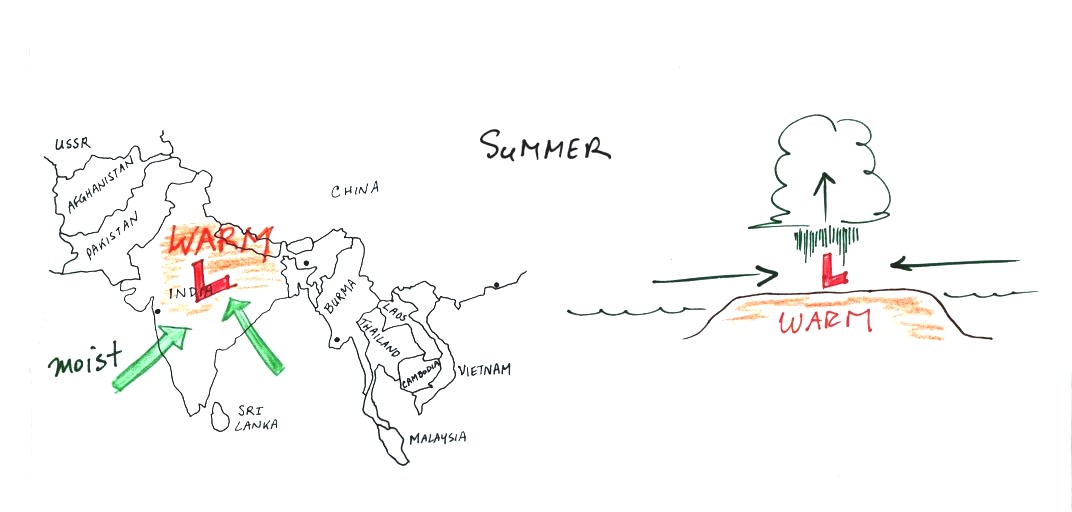
In the summer India and SE Asia become warmer than the
oceans
nearby. Surface low pressure forms over the land, moist winds
blow from the ocean onshore, and very large amounts of rain can
follow.

The winds change directions in the winter when the
land becomes colder
than the ocean.
You can
also use the thermal circulation to understand some of the basic
features of the El Nino phenomenon (you find a discussion of the El
Nino on pps 135-139 in the photocopied Classnotes).
First here is what conditions look like in the tropical Pacific Ocean
in non-El Nino years.

Cold ocean currents along the west coasts
of N. America and S.
American normally converge at the equator and begin to flow westward
(see top view above). As the water travels westward it
warms. Some of the warmest sea surface waters are normally found
the western Tropical Pacific. A temperature gradient becomes
established between the W. and E. ends of the tropical Pacific. The
crossectional view above shows the normal temperature and circulation
pattern found in the equatorial Pacific Ocean. You would
find surface high pressure in the east and low pressure in the
west. Note that the wind circulation pattern is the same as the
simple thermal circulation we studied above.
Colder than normal ocean waters in the E. Pacific is referred to as a
La Nina event. La Nina conditions have developed at the present
time. You can find up to date information on El Nino/La Nina
conditions at a Climate
Prediction Center website.
The Climate Prediction Center expects the La Nina conditions to
have the following effects on winter weather in the western and
southeastern United States: "Expected
La Nina impacts during November - January include above average
precipitation in the Northern Rockies, Northern California, and in
southern and eastern regions of the Pacific Northwest.
Below-average precipitation is expected across the southern tier,
particularly in the southwestern and southeastern states."
In
an El Nino year the cold currents don't make it to the
Equator. Warm water is carried from the western Pacific to the
eastern Pacific
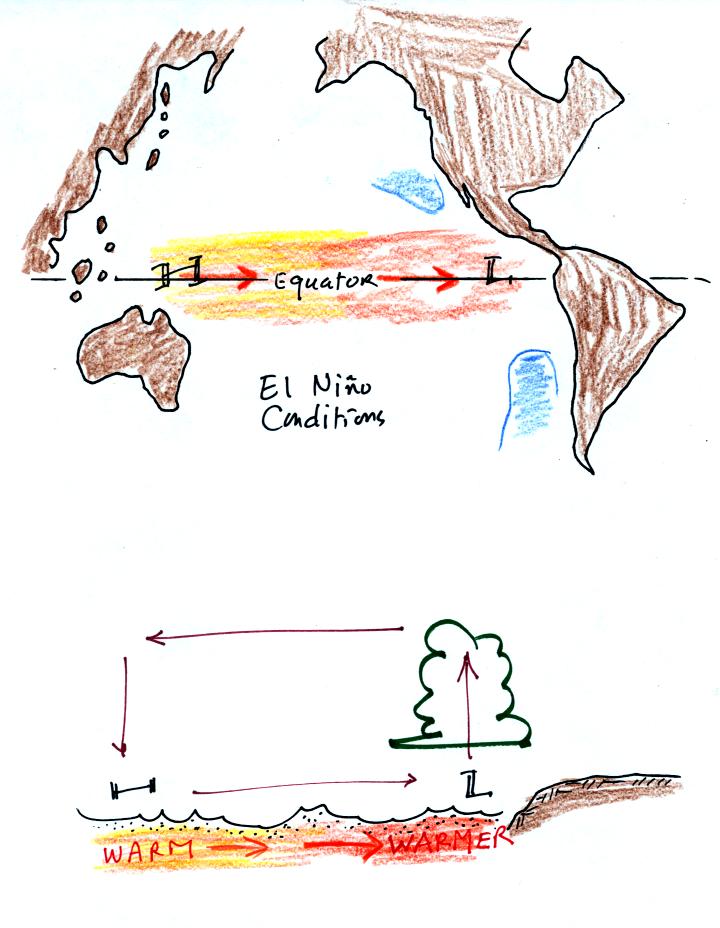
Now surface high pressure is found in the west and
surface low
pressure and rising air is found in the E. Pacific (the reversal in the
surface pressure pattern is referred to as the southern
oscillation). Indonesia and Australia often experience drought
conditions during El Nino events. In the desert SW we expect
slightly wetter than normal conditions (perhaps 20% wetter than
normal). Wetter conditions are also found in California and in
the SE US.
At this
point we took a little detour.
You might already have heard that water spins in a different direction
when it drains from a sink or a toilet bowl in the southern hemisphere
than it does in the northern hemisphere. You might also have
heard that this is due to the Coriolis force or the Coriolis
effect.
We've just finished learning about the Coriolis force. It does
cause winds to spin in opposite directions around high and low pressure
centers in the northern and southern hemisphere. The
PGF starts the air moving (in toward low, out and
away from high pressure) then the Coriolis force bends the wind to the
right (N. hemisphere) or to the left (S. hemisphere).
Here's what you end up with in the case of low pressure (see p. 130 in
the photocopied Classnotes):
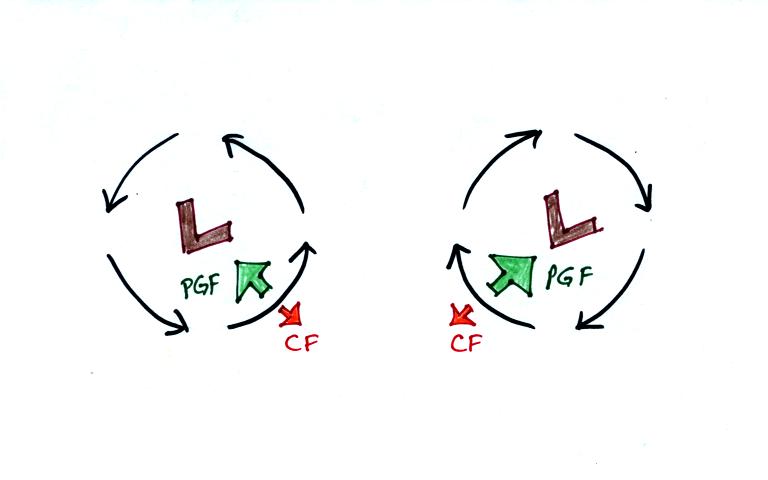
The PGF is stronger than the CF. This results in
a net inward force, something that is needed to keep winds blowing in a
circular path.
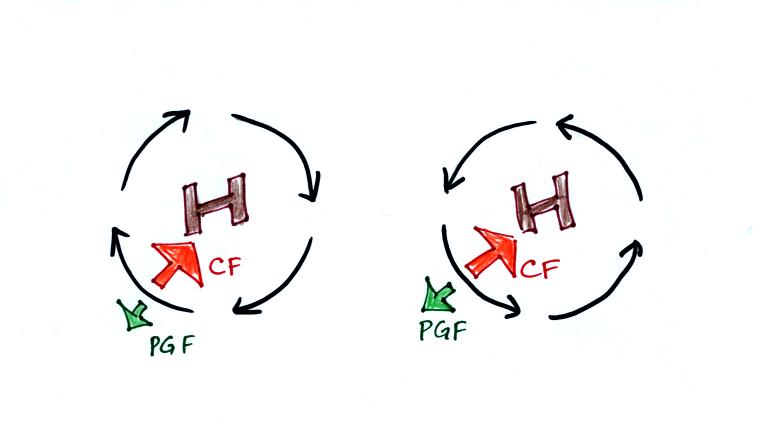
Winds also spin around high pressure. The CF is critical
in this case. The CF is stronger than the PGF and the CF points
inward. The CF is what provides the needed inward force needed to
keep the winds blowing in a circular path.
There are situations where the PGF is much stronger than the CF.
The CF is so weak it can be ignored. This is the case with
tornadoes, winds spin around a core of very low pressure.

Winds can still spin around LOW. The PGF supplies the
necessary net inward force.
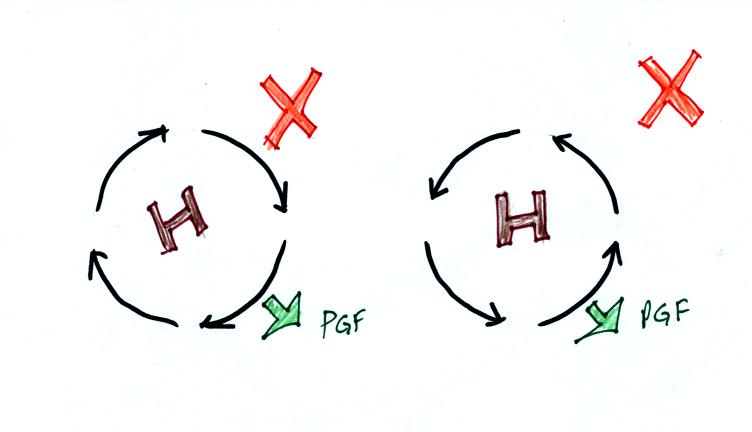
The PGF points ouward with high pressure. Without the CF,
there isn't any inward force, winds can't spin around high without the
CF.
Water can spin in either direction in either hemisphere as it drains
from a sink, a toilet bowl, or a bucket (with a hole in the bottom)
such as was used in the video segment shown in class.

The CF doesn't play any role at all. The following figure shows
that there is just an inwardly directed pressure gradient force.

If you look closely at water spinning in a bucket or
sink you will
notice that the surface of the water has a bowl shape. The water
piles up and is deeper along the sides of the bucket than it is in the
center. An inwardly directed pressure gradient force is
created. The deeper water near the sides of the bucket produces a
little higher pressure inside the water than the shallower water near
the center of the bucket. This radial difference in pressure is what
keeps the box of water spinning in a circular path.
Now
back to another new topic covered in class today.
We'll
apply the thermal circulation idea to a global scale and try to learn
something about global scale pressure and wind patterns on the
earth. Ordinarily you couldn't apply a small scale phenomena like
a thermal circulation to the much larger global scale. However if
we make some simplifying assumptions, particularly if we assume that
the earth doesn't rotate or only rotates slowly, we can ignore the
Coriolis force.
Some additional simplifications are also made and are listed below (p.
133 in the photocopied Classnotes)

Because the earth isn't tilted, the incoming sunlight shines
on the earth most directly at
the
equator. The equator will become hotter than the poles. By
allowing the earth to rotate slowly we spread this warmth out along the
entire length of the equator rather than concentrating it in a spot on
the side of the earth facing the sun. Because the
earth is of uniform composition there aren't any temperature
differences created between large bodies of water and land
masses.
You can see the wind
circulation pattern that would develop. The term one cell
just means there is one complete
loop
in the northern hemisphere and another in the southern hemisphere.
Next we will remove the assumption concerning the rotation of the
earth. We won't be able to ignore the Coriolis force now.

Here's what a computer would predict you would now see on
the earth. Things are pretty much the same at the equator in the
three cell and one cell models: low pressure and rising air. At
upper levels the winds begin to blow from the equator toward the
poles. Once headed toward the poles the upper
level winds are deflected by the Coriolis force.
There end up being three closed loops in the northern and in the
southern hemispheres. There are belts of low pressure
at the equator (the equatorial low)
and at 60 degrees latitude (the subpolar
low). There are belts of high pressure (the subtropical high) at 30
latitude and high pressure centers at the two poles (the polar highs).
We will look at the surface features in a little more detail because
some of what is predicted, even with the unrealistic assumptions, is
actually found on the earth.
We'll first look at surface pressures and winds on the earth from 30 S
to 30 N, the tropics and subtropics.
Then we'll look at the region from 30 N to 60 N, middle
latitudes, where most of the
US is located.
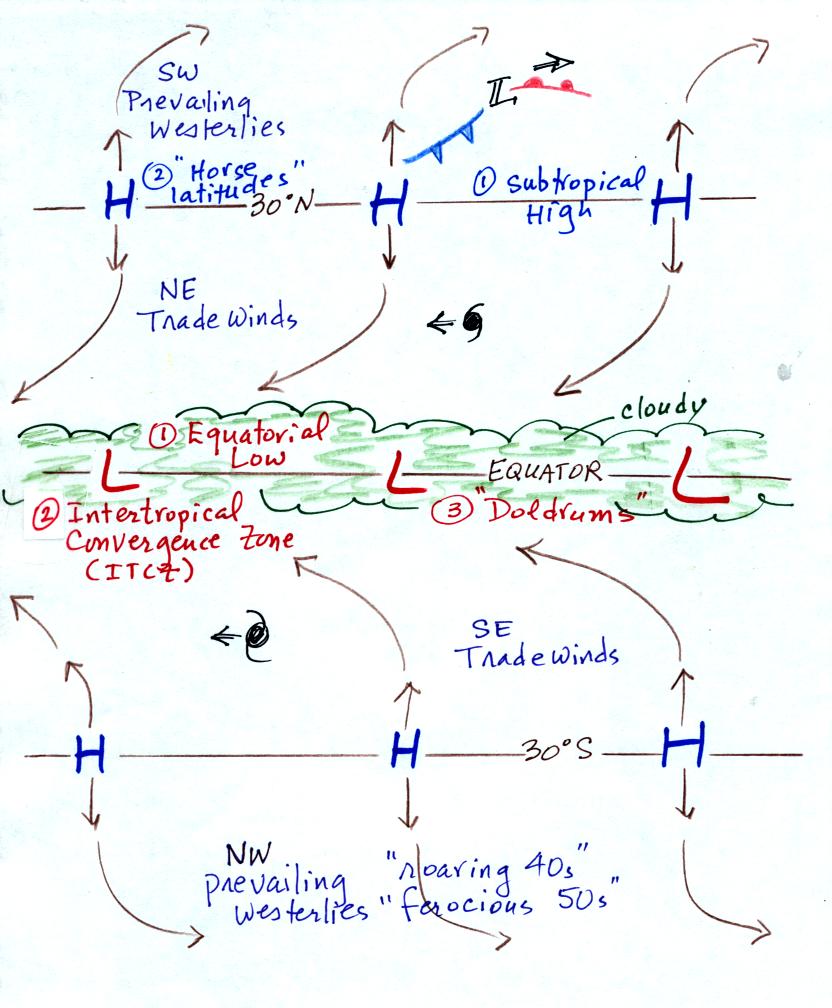
With a little study you should be able to start with a blank
sheet of paper and reproduce this figure. I would suggest
starting at the equator. You need to remember there is a belt of
low pressure found there. Then remember that the pressure belts
alternate: there are belts of high pressure at 30 N and 30 S.
Let's start at 30 S.
Winds will begin to
blow from High pressure at 30 S toward Low pressure at the
equator. Once the winds start to blow they will turn to the left
because of the Coriolis force. Winds blow from 30 N toward the
equator and turn to the right in the northern hemisphere (you need to
turn the page upside down and look in the direction the winds are
blowing). These are the Trade
Winds (northeasterly trade winds north of the equator and
southeasterly trades south of the equator). They converge at the
equator and the air there rises (refer back to the crossectional view
of the 3-cell model). This is the cause of the band of clouds that you
can often see at or near the equator on a satellite photograph.
The Intertropical Convergence Zone or ITCZ is another name for the
equatorial low pressure belt. This region is
also referred to as the doldrums because it is a region where surface
winds are often weak. Sailing ships would sometimes get stranded
there hundreds of miles from land. Fortunately
it is a cloudy and
rainy region so the sailors wouldn't run out of drinking water.
Hurricanes form over warm ocean water in the subtropics between the
equator and 30
latitude. Winds at these latitudes have a strong easterly
component and hurricanes, at least early in their development, move
from east to west. Middle latitude storms found between 30 and 60
latitude, where the prevailing westerly
wind belt is found, move from
west to east.
You find sinking air, clear skies, and weak surface winds associated
with the subtropical high pressure belt. This is also known as
the horse latitudes. Sailing ships could become stranded there
also. Horses were apparently either thrown overboard (to conserve
drinking water) or eaten if food supplies were running low. Note
that sinking air is associated with the subtropical high pressure belt
so this is a region on the earth where skies are
clear (Tucson is
located at 32 N latitude, so we are affected by the subtropical high
pressure belt).
The winds to the north of 30 N and to the south of 30 S are called the
"prevailing westerlies."
They blow from the SW in the northern hemisphere and from the NW in the
southern hemisphere. The 30 S to 60 S latitude belt in the southern
hemisphere is mostly ocean. Because there is less friction over
the oceans, the prevailing westerlies there can
get strong, especially in the winter. They are sometimes referred
to as the "roaring 40s" or the "ferocious 50s" (the 40s and 50s refer
to the latitude belt they are found in).

Here's the other map, it's a little simpler. Winds
blowing north from H
pressure at 30 N toward Low pressure at 60 N turn to the right and blow
from the SW. These are the "prevailing westerlies."
The polar easterlies are cold winds coming down from high pressure at
the north pole. The subpolar low pressure belt is found at 60
latitude. This
is also a convergence zone where the cold polar easterly winds and the
warmer prevailing westerly winds meet. The boundary between these
two different kinds of air is called the polar front and is often drawn
as a stationary front on weather maps. A strong current of winds
called the polar jet stream is found overhead. Strong middle
latitude storms will often form along the polar front.
The following material wasn't covered
in class on Tuesday. We may review some of it quickly at
the start of class on Thursday.
We studied the 3-cell model because some of the features it predicts
(despite the simpliying and unrealistic assumptions) are really found
on the earth.
We assumed that the earth wasn't tilted. Let's look at how
allowing the N. Pole to tilt toward the sun in June and away from the
sun in December will affect the 3-cell model features.

The top figure shows the normal locations of the belts of Low and
High pressure in the 3-cell model when the earth isn't tilted.
As the N. Pole tilts toward the sun in the middle figure, the sun's
rays will strike the earth most directly at a location north of the
equator (at the Tropic of Cancer). That is where the equatorial
low will be found, north of its normal location. Similarly the
other 3-cell model features will all be displaced to the north of their
normal positions.
As the N. Pole tilts away from the sun in the bottom figure the 3-cell
model features move south of their normal locations.
We'll see this north and south movement of the 3-cell model features in
the next figure as well.

The 3-cell model predicts subtropical belts of high
pressure near
30
latitude. What we really find are large circular centers of high
pressure. In the northern hemisphere the Bermuda high is found
off the east coast of the US (feature 3 in the figure), the Pacific
high (feature 4) is positioned
off the
west coast. Circular low pressure centers, the Icelandic low
(feature
2) and
Aleutian low (feature 1), are found near 60 N. In the southern
hemisphere you
mostly just find ocean near 60 S latitude. In this part of the
globe the assumption of the earth being of uniform composition is
satisfied and a true subpolar low
pressure belt as predicted by the 3-cell model is found near 60 S
latitude.
The equatorial low or ITCZ is shown in green. Notice how it moves
north (when the north pole is tilted toward the sun) and south of the
equator (when the north pole is tilted away from the sun) at different
times of the year.
The winds that blow around these large scale high and low pressure
centers create the major ocean currents of the world. If you
remember that high pressure is positioned off the east and west coast
of the US, and that winds blow clockwise around high in the northern
hemisphere, you can determine the directions of the ocean currents
flowing off the east and west coasts of the US. The Gulf Stream
is a warm current that flows from south to north along the east coast,
the California current flows from north to south along the west coast
and is a cold current. A cold current is also found along the
west coast of South America (a disruption of this current often signals
the beginning of an El Nino event); winds blow counterclockwise around
high in
the southern hemisphere. These currents are shown in the enlargement
below.
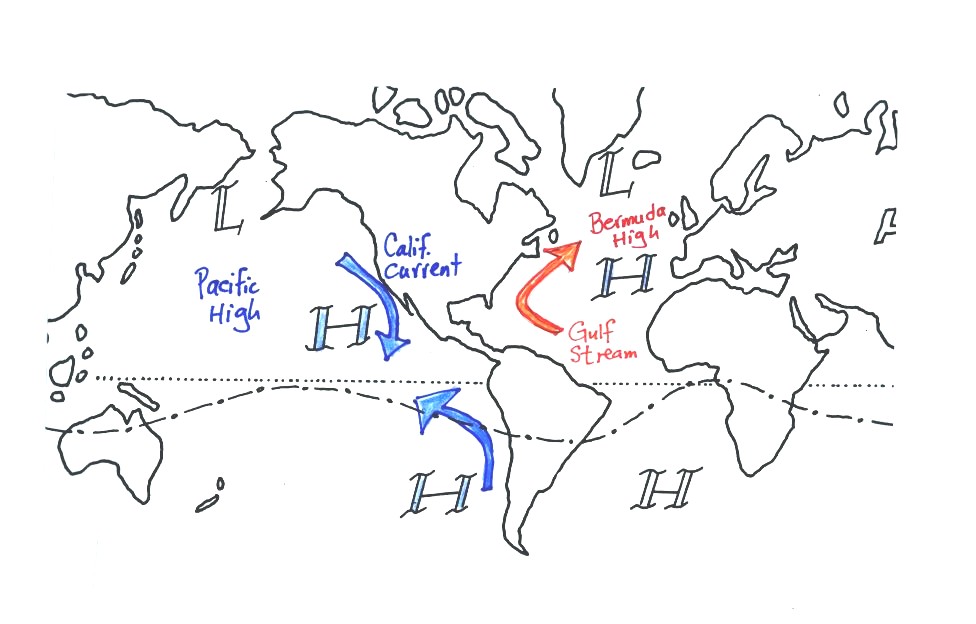
The north and south movement of subtropical high has a big effect on
weather in Arizona.
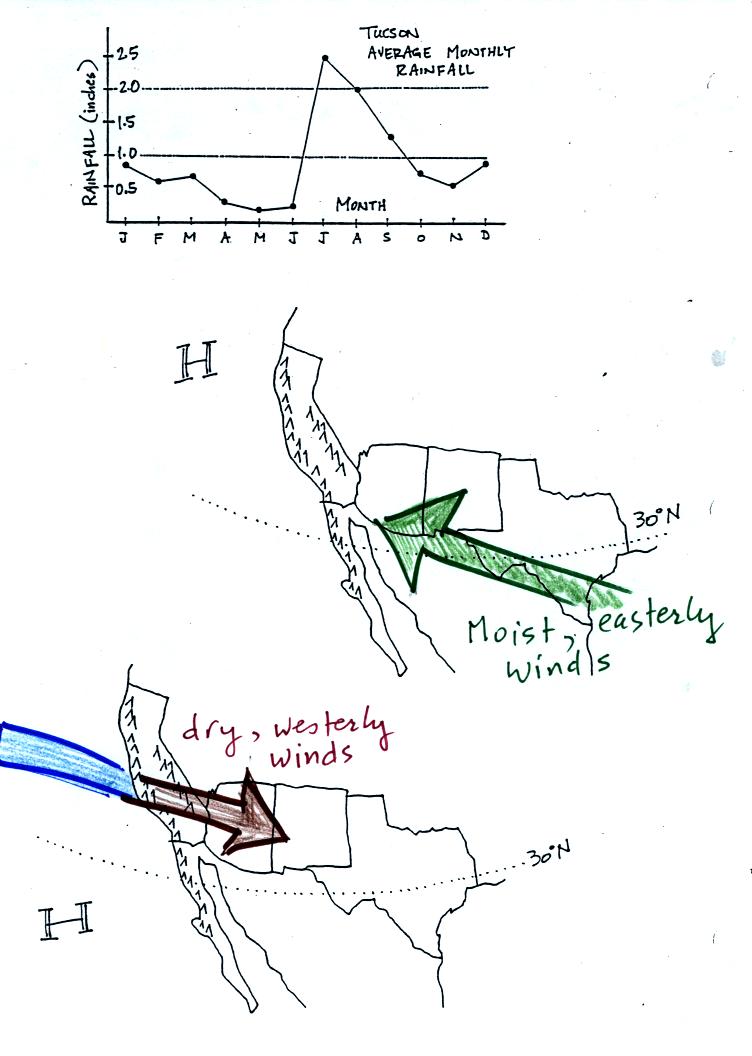
Tucson gets about 12 inches of rain in a normal year (we are well below
normal at this time this year). About half of this comes during
the "summer monsoon" season. The word monsoon refers to a
seasonal change in wind direction. During the summer subtropical
high pressure moves north of its normal position near 30 N
latitude. Winds on the southhern side of the subtropical high
have an easterly component. Moist air originating in Mexico
and the Gulf of Mexico blows into Arizona. The sun heats the
ground during the day, warm air in contact with the ground rises and
produces convective thunderstorms.
The close proximity of the Pacific high, with its sinking air motions,
is what gives California, Oregon, and Washington dry summers.
In the winter the subtropical high moves south of 30 N latitude.
Winds to the north of the high blow from the west. Air
originating over the Pacific Ocean loses much of its moisture as it
crosses mountains in California (remember the rain shadow
effect). The air is pretty dry by the time it reaches
Arizona. Significant winter rains occur in Arizona when storms
systems are able to draw moist subtropical air from the southwest into
Arizona.
























